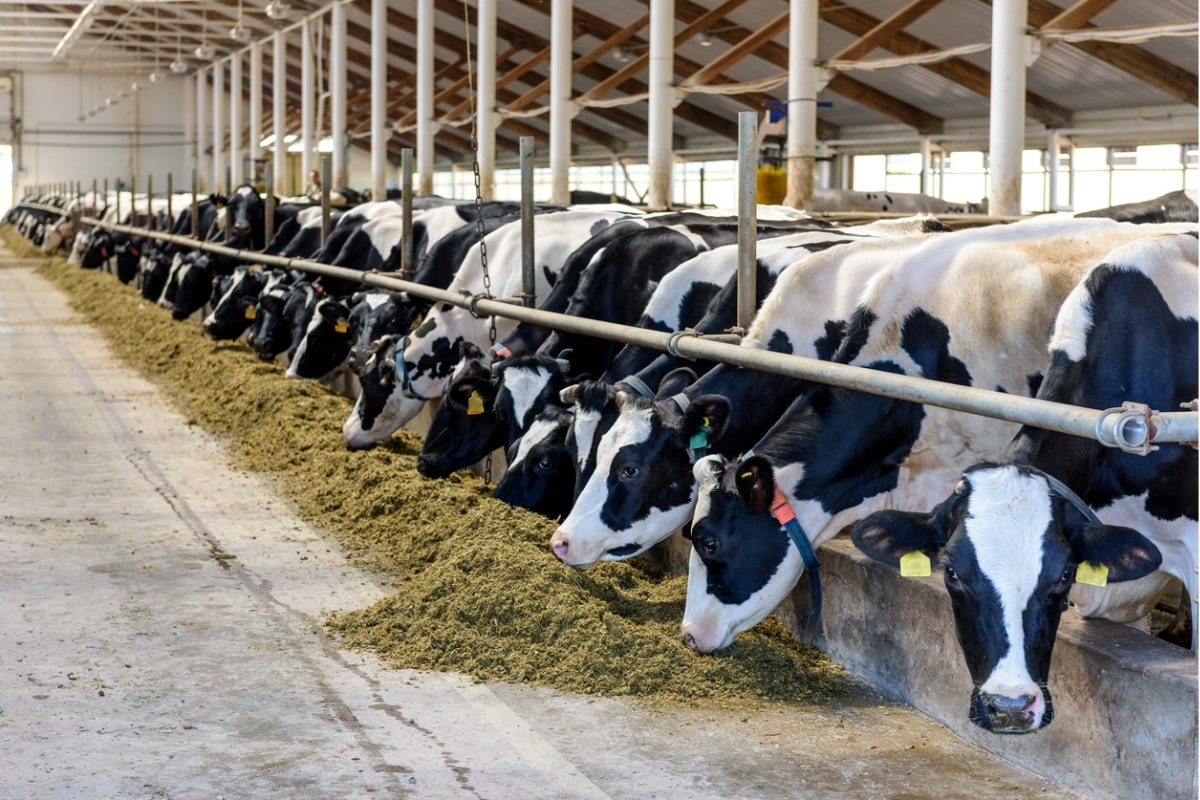If you are struggling with cow productivity, rumen health, and feed efficiency, understanding and applying the total mixed ration (TMR) feeding strategy can make a big difference. However, simply feeding dairy cows a TMR doesn’t guarantee positive results. You also need proper feeding management and high-quality ration ingredients. Let’s break down how to avoid common pitfalls and get the most from your dairy cattle feed rations.
Total Mixed Rations in a Nutshell
A total mixed ration (TMR) is a feeding method in which every bite contains a uniformly balanced proportion of all ingredients. A dairy cow TMR is composed of all feed ingredients, including forages, grains, protein sources, byproducts, minerals, vitamins, and other feed additives. All components are blended according to a carefully formulated ration recipe designed to meet the specific nutritional needs of your herd.
Advantages of a Total Mixed Ration for Dairy Cows
TMR feeding offers multiple advantages for dairy farmers. Essentially, TMR improves feeding efficiency, cow health, and development. These advantages ultimately play a crucial role in boosting overall farm efficiency and profitability.
- TMR can provide about 4% higher feed utilization compared to conventional feeding, according to Pennsylvania State University. It can also improve rates of breakdown for various feeds, further increasing feed utilization.
- Each bite is balanced, preventing cows from consuming significantly more or less forage or concentrate than their ration plan requires.
- More stable rumen pH. Since cows can’t engorge on starch, and they get adequate fiber in each bite, they experience fewer digestive upsets. The risk of subacute rumen acidosis (SARA) is reduced.
- Higher milk production. Dairy farmers can boost milk yield by as much as 5% with TMR, or about 2 to 5 lbs per cow per day, as noted by the University of Minnesota.
- Reduced picky eating. Since TMR is homogeneous, cows can’t focus on the “tasty” grains while avoiding the equally important but less appealing feed.
- You can “sneak in” less palatable ingredients like urea, limestone, or fat sources that cows might otherwise avoid. Cows consume them without noticing, while still benefiting from a balanced diet. This approach also boosts cost-effectiveness, particularly when incorporating by-products or alternative feeds, allowing you to reduce feed costs and capitalize on seasonal options like distillers’ grains.
- Reduced labor and easier feeding management. TMR streamlines your operation by delivering all feed to the bunk as a single, consistent ration.
How to Get the Most Out of the TMR Diet for Your Herd
In theory, TMR is a near-perfect way to feed cattle. But it requires proper execution to genuinely benefit from it. Because it standardizes your herd’s diet, success depends on making sound decisions and applying effective management practices at every step. Any mistake in the TMR process affects every cow in the herd.
Choose the Right TMR Mixer and Use It Correctly
While many types of TMR mixers are available, the best choice depends on your specific needs. Factors to consider include mixer size, mobility, compatibility with scales and magnets, maintenance requirements, and its ability to handle all the feedstuffs in your TMR diet. For instance, some horizontal mixers struggle with hay or bales because these materials can wrap around the augers.
Improper use or poor maintenance can cause significant problems. Even small issues—like dull knives or an unlevel mixer—can interfere with processing hay and other ingredients, disrupting the entire ration. Other common problems include inconsistent mixing time and insufficient mixing power. Always run the mixer to its capacity and with the same load and mixing time.
Prevent TMR Sorting With Particle Size Management
If the TMR ingredients’ particle sizes are too large or too small for their respective percentages in the mix, cows can still manage to sort them out and only eat what they find appealing, says Hoard’s Dairyman. Ensuring that particles are chopped to the correct size, mixed thoroughly, and have sufficient moisture will help reduce sorting issues.
Don’t Over or Undermix
Overmixing and undermixing can compromise the quality of a TMR. Undermixing results in a non-uniform ration, defeating the purpose of TMR by leaving particles unevenly distributed. Overmixing, on the other hand, grinds the feed too finely, producing overly small particles. This can increase the risk of SARA and lead to reduced feed intake and milk production.
Work With Your Nutritionist
Don’t hesitate to include your diary nutritionist in the TMR formulation process. Here at Star Blends, we can manufacture custom cattle feed according to your nutritionists’ recommendations to ensure your TMR meets your herd’s requirements. Likewise, you should test your forage regularly to prevent any feed insufficiencies due to poor quality, spoilage or other factors.
Should All Cows Have the Same TMR Diet?
Typically, no. You will need several TMR groups to fully maximize the benefits. For example, you can have separate TMR feeds for pre-fresh, fresh, high-producing, first-lactation, mid-lactation, late lactation, and dry cows. Since they have unique dietary requirements, you need to customize rations for every group. While this requires multiple TMR mixes, it also makes handling nutrition for different life stages far easier and systematic.
What Makes a High Quality Dairy TMR?
The most critical aspects of TMR nutritional effectiveness are the composition and quality of the ingredients. Let’s take a closer look at each:
Nutrient Composition
Factors such as moisture levels, storage conditions, forage harvest dates, growing conditions, and variability between forage sources can lead to ingredients with inconsistent nutrient profiles. As a result, the protein, fat, carbohydrate, and micronutrient content of the TMR may fluctuate unless you take specific measures to maintain a consistent nutritional profile.
Quality of Ingredients
Always work with a reputable feed supplier like Star Blends that hold HACCP certifications. Ingredients should be transported, stored, and mixed under strict quality standards to preserve nutritional value and prevent safety risks. A trustworthy supplier like Star Blends will confidently answer questions about their processes, giving you insight into their expertise and the quality of feed they can deliver.
Formulate Your Custom TMR With Star Blends
A quality TMR can improve milk production, feed efficiency, and cow health. Star Blends will work alongside your nutritionist to design, evaluate, and adjust TMRs for consistent results and fewer feed-related issues. Contact our team, and we’ll help you and your nutritionist build a more balanced and productive cow rations from the ground up.



